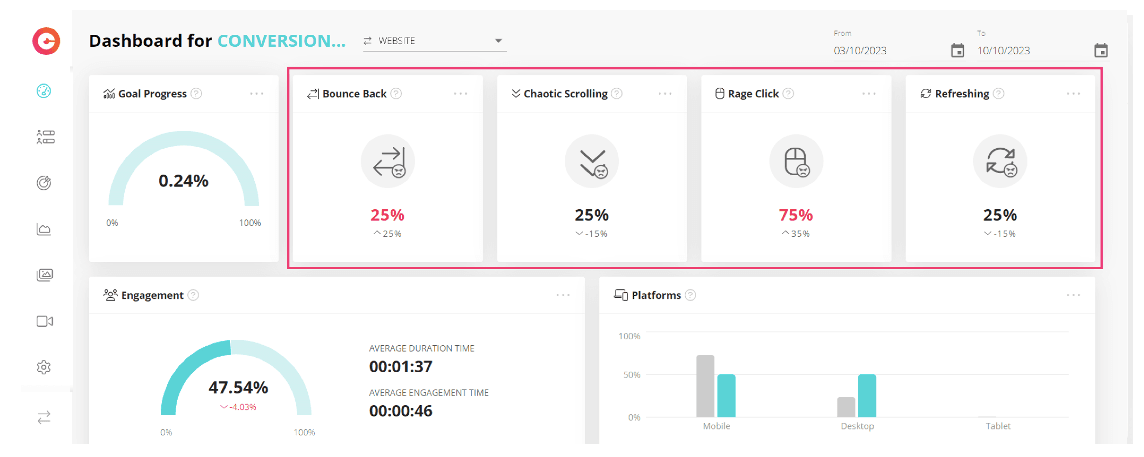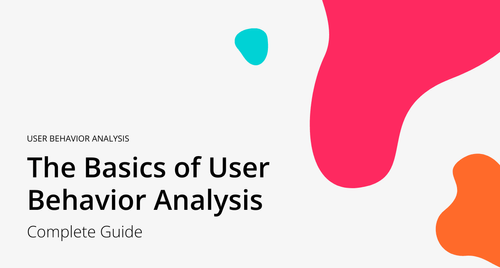User Behavior Analytics
6.05.2024
6 minutes read
Decode your visitors with Experience Metrics
Ever spend hours crafting the perfect landing page, only to see bounce rates skyrocket? Traffic seems good, but conversions are lagging. The design looks polished, yet users just aren't clicking where you expect them to. What's the missing piece?

List of Contents
Ever spend hours crafting the perfect landing page, only to see bounce rates skyrocket? Traffic seems good, but conversions are lagging. The design looks polished, yet users just aren't clicking where you expect them to. What's the missing piece?
When we want to understand how users really use a website or product, we need more than the usual numbers. In this article, we'll discuss a powerful set of metrics that can help you uncover hidden user pain points that may be the reasons why they come, they see, and they...bounce.
What are Experience Metrics?
Experience Metrics in CUX provide you with all of the most relevant data regarding your visitors' overall experience on your website. CUX's algorithm detects user behavior patterns that may indicate technical or usability issues (points of frustration) on your website. These frustrations are then presented as actionable metrics, pinpointing specific pages and user behaviors that need attention. Essentially, Experience Metrics empower you to proactively enhance your website's user experience, ensuring that visitors feel satisfied and engaged rather than frustrated and driven away.

Why frustration matters?
Ever felt the urge to scream at a website that just won't cooperate? You're not alone. Website frustration is the ultimate mood killer, turning happy browsers into click-abandoning rage-quitters faster than you can say "404 error." And these frustrated visitors aren't just annoyed... they're lost leads and missed sales opportunities. By identifying and addressing points of frustration, you can create a smoother, more enjoyable user experience that keeps visitors coming back for more.
Experience Metrics in action
Zooming
When users zoom in or out on your website, it's a sign they're struggling to see the content clearly or interact with it comfortably. For example, a user might repeatedly pinch-zoom on product images, indicating that they need a closer look to make a decision.
Trigger: Poor image quality that lacks sufficient detail when viewed on a mobile device.
Rage Click
This metric lights up when users repeatedly click in frustration, often signaling a problem with usability or functionality. For instance, imagine a user trying to submit a form but encountering errors, leading them to angrily click the submit button multiple times in quick succession.
Trigger: Confusing button placement, unclear form instructions, technical errors that prevent form submission.
Rage Key Press
Similar to Rage Clicks, a spike in Rage Key Press (rapid key mashing on desktop) might suggest a frustrating form field or login process that isn't user-friendly.
Trigger: A login form requiring overly complex passwords or special characters, a form field that doesn't accept valid input, technical glitches preventing form submission.
Refreshing
Users refreshing a page repeatedly may indicate issues with content loading or navigation. For instance, if users keep refreshing a checkout page, it could signal confusion or errors in the payment process.
Trigger: Large image files or unoptimized code causing slow loading times, server-side errors preventing the page from loading properly.
Chaotic Movement
Imagine a visitor's mouse cursor darting around erratically on a product page. This Chaotic Movement suggests confusion or difficulty finding relevant information. The product page layout might be cluttered or overwhelm visitors.
Trigger: Confusing navigation menus, overwhelming product listings with poor organization, lack of clear calls to action.
Chaotic Scrolling
Rapid, up-and-down scrolling is a classic sign of Chaotic Scrolling. This might indicate content that's too long, poorly organized, or lacks a clear hierarchy, making it difficult for users to find what they need.
Trigger: Extremely long blog posts without proper section breaks or headings, content that lacks clear visual hierarchy, information overload with too much text and not enough visuals.
Dead Clicks
Have you ever clicked a button that looks clickable but doesn't do anything? Dead Clicks expose these phantom elements on your website. These could be non-clickable images or broken buttons that frustrate users and disrupt their browsing flow.
Trigger: Broken links, buttons with outdated functionality.
Bounce Back
Bounce Back specifically refers to a single-page session on your website. The visitor landed on a page but didn't interact with it further (clicking links, scrolling down, filling out forms) and left immediately.
For example high Bounce Back rate on a specific blog post could indicate irrelevant content or a misleading title that doesn't accurately reflect the post's content. This leads visitors to leave the page immediately after landing on it.
Trigger: Misleading title or description that doesn't accurately reflect the content, content irrelevant to the visitor's search intent, slow loading times, mobile un-friendly design.
Become a UX master: embrace data and curiosity
Don't be afraid to dig deep into your Experience Metrics! The more you understand how users interact with your site, the better you can make it. Here are some bonus tips to become a UX champion:
- Be inquisitive! Always ask "why?" Why did users abandon that form? Why are they scrolling so erratically? The answers to these questions will guide your improvements.
- Befriend analytics tools! Experience metrics are gold, and CUX is the best tool in the business for uncovering them. Use the power of data to become a UX legend!
Where to find Experience Metrics in CUX
CUX conveniently places Experience Metrics in several key areas for easy access and analysis.
Dashboard
Provides a quick overview of user frustrations relevant to your chosen goals. Ideal for a high-level understanding.
Experience Metrics Tab
Offers a deep dive into all metrics, including percentages of visits with specific patterns, distribution over time, and URLs where these patterns occur most frequently. Great for detailed analysis.
Goals Section
Focuses on visits that achieved specific goals and highlights Experience Metrics relevant to those successful sessions. It's a great way to understand what's working and what needs improvement.
Heatmaps
Heatmap is a visual representation of users actions, based on events like clicks, link clicks, or mouse movements. Plus, you'll also spot some Experience Metrics like Rage Clicks, Dead Clicks, and Zoom on the heatmap. To make it even more useful, you can filter heatmaps using the Experience Metric filter on the Heatmaps page.
Visit Recordings
And if you really want to get up close and personal, take a look at the visit recordings. Visit recordings provide a detailed playback of individual user sessions on a website, capturing the user's entire journey with all interactions and Experience Metrics. When an Experience Metric is detected during a session, you'll see it highlighted as a pink indicator on the timeline of the CUX player. Additionally, the filter option allows you to filter recordings based on specific Experience Metrics.
All-in-one user experience insights with CUX
CUX empowers you to unlock the full potential of your website with everything you need for user experience optimization. From detailed heatmaps to comprehensive visit recordings, CUX provides a wealth of data to inform your decisions. By leveraging Experience Metrics, you can identify pain points, prioritize improvements, and ultimately boost conversions by enhancing the overall user experience

5/10/2023
6 minutes read
CUX Insights: Understanding your product through data
In the world of digital products, it's crucial to understand and improve how users experience them. This article explores how data is the key to achieving this goal.
Read more
28/02/2024
6 minutes read
The Basics of User Behavior Analysis - CUX Complete Guide
In the ever-evolving landscape of digital experiences, understanding user behavior has become a cornerstone for businesses striving to stay ahead.
Read more
11/06/2021
6 minutes read
Customer journey optimization
Most businesses want to improve the customer experience across all of their digital properties. Including websites, social media, blogs, and so on.
Read more
